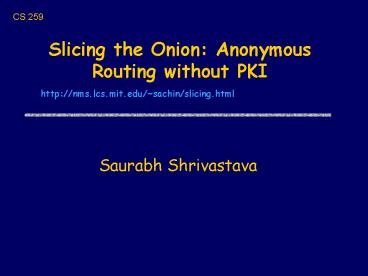Slicing the Onion: Anonymous Routing without PKI - PowerPoint PPT Presentation
Title:
Slicing the Onion: Anonymous Routing without PKI
Description:
CS 259 Slicing the Onion: Anonymous Routing without PKI http://nms.lcs.mit.edu/~sachin/slicing.html Saurabh Shrivastava – PowerPoint PPT presentation
Number of Views:86
Avg rating:3.0/5.0
Title: Slicing the Onion: Anonymous Routing without PKI
1
Slicing the Onion Anonymous Routing without PKI
CS 259
http//nms.lcs.mit.edu/sachin/slicing.html
- Saurabh Shrivastava
2
What is Onion Routing
- - packets are encrypted in layers
- - each node decrypts the packet using its key,
figures out the next hop - - usually public/private key pairs used, but here
symmetric keys will be used - - how to distribute the keys to nodes? use
information slicing split the key into lots of
pieces, send them on disjoint paths to the
respective target nodes
3
Key Distribution
- Bob reassembles message it received from Ne and
Nb to yield IB1, IB2 meant for him and also Ia1
to be sent to Na, Id2 to be sent to Nd. - here there are 3 stages (L), split factor is 2
(d)
4
Anonymity
- Degree of Anonymity
- Measured as entropy of the system
- Unlinkability
- of different actions by a single user
- Source/Destination anonymity
- Source is hidden from all nodes including
destination, (same argument for destination) - We will focus on Source anonymity
5
Observations
- If the adversary is in control of a stage, it can
get all information about keys and nodes in
subsequent stages - If the adversary doesnt control all the nodes in
a stage, it is as good as controlling only 1 node
in that stage. - Adversary cannot correlate information if its
nodes are not in consecutive stages - Best case scenario is when
- 1st stage is compromised or else
- the adversary has only 1 node in consecutive
stages
6
Adversary Model
- Adversary controls a fraction of nodes in the
graph - It is able to figure out if it has nodes in
consecutive stages and if it has multiple nodes
in some stage - It knows about the parameters L (number of
stages) and d (splitting factor) - It tries to find the single largest chain of its
nodes and tries to guess that the node prior to
its chain head is the source (its guess will be
good only if its chain head lies in the first
stage)
7
Analysis
- Given L, d, f, figure out all possible
arrangements of adversary nodes in the graph
(hard). More later. - For each arrangement figure out what is the
longest chain of adversary nodes possible (easy) - Given the length of the chain, find out the
likelihood of correct guess of the source (easy)
e.g. if L is 10, chain length is 7, chances are
0.25 that the head is in stage 1 - The authors did it differently they assumed a
network of N100,000 nodes, of which fraction f
were malicious, chose Ld nodes from N (some of
which were malicious) and ran simulations to find
chain lengths.
8
Anonymity dependent on L
- If L increases, the adversary nodes are spread
out and it is more difficult to form unbroken
chains with nodes in consecutive stages. - Broken chains render adversary nodes useless
because it cannot correlate nodes if not part of
the same chain
9
Anonymity dependent on d
- When f is low, increasing d creates more chances
for the adversary to have nodes in consecutive
stage - When f is high, there is high likelihood that
adversary controls an entire stage, so increasing
d will break this scenario
10
Analysis 2
- Didnt use Murphi, or any tool, used C programs
to achieve the hard part (Given L, d, f,
figure out all possible arrangements of adversary
nodes in the graph) - given L (6) , d (4), f (.25), m (6) L d
f - find all partitions of m such that none of the
terms is gt d - find out how many 1-chain, 2-chain, 3-chain ..
m-chains can be made - ./arrangements 6 4 ../partitions/p6 m6d4
- 2 28 gt given 2 stages with d4, how
many ways can we choose places for 6 adversary
nodes (partitions used 2,4 3,3 4,2) - for all possible permutations of m adversary
nodes in Ld nodes find out frequency of 1 chain,
2 chain 3 chain ... m-chain - ./chains 6 4 .25 L6d4f25
- 0xb 3 2 604800.000000 gt 3 stages in which
adversary nodes present (0 0 1 0 1 1) but the
effective chain length is only 2. 604800 all
possible combinations of 6 adversary nodes when
present in 3 stages with d4.

